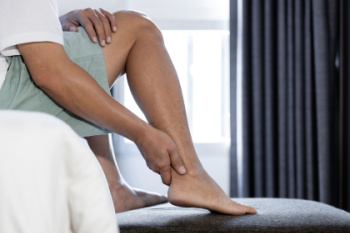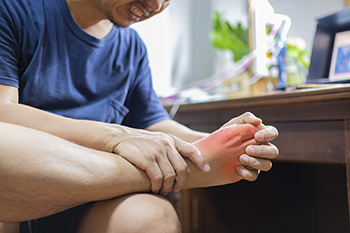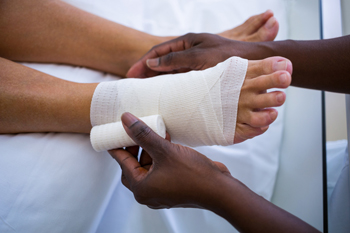Connect With Us
Blog

Recovering from a torn Achilles tendon necessitates a strategic approach, wherein the guidance of a podiatrist can prove invaluable. Whether opting for surgical intervention or a non-surgical route, the journey entails careful progression and diligent rehabilitation. Following initial immobilization, facilitated by a plaster cast, the rehabilitation plan, overseen by a podiatrist, emphasizes gradual reintroduction of movement, range of motion exercises, and flexibility work. Surgical interventions similarly involve a period of postoperative immobilization, followed by structured rehabilitation under the supervision of a podiatrist. The anticipated timeline for recovery spans approximately six to nine months. Close monitoring by a podiatrist ensures proper loading of the healing tendon while mitigating the risk of reinjury. Heat therapy, ice application, and flexibility training, all incorporated into the rehabilitation regimen, play pivotal roles in fostering optimal healing. Patience, adherence to the prescribed plan, and collaboration with a podiatrist are needed for achieving successful outcomes and restoring function and strength to the injured tendon. If you have injured your Achilles tendon, it is suggested that you schedule an appointment with a podiatrist for an exam and treatment options.
Achilles tendon injuries need immediate attention to avoid future complications. If you have any concerns, contact Dr. Yeon A. Shim of Roselle Podiatry Group. Our doctor can provide the care you need to keep you pain-free and on your feet.
What Is the Achilles Tendon?
The Achilles tendon is a tendon that connects the lower leg muscles and calf to the heel of the foot. It is the strongest tendon in the human body and is essential for making movement possible. Because this tendon is such an integral part of the body, any injuries to it can create immense difficulties and should immediately be presented to a doctor.
What Are the Symptoms of an Achilles Tendon Injury?
There are various types of injuries that can affect the Achilles tendon. The two most common injuries are Achilles tendinitis and ruptures of the tendon.
Achilles Tendinitis Symptoms
- Inflammation
- Dull to severe pain
- Increased blood flow to the tendon
- Thickening of the tendon
Rupture Symptoms
- Extreme pain and swelling in the foot
- Total immobility
Treatment and Prevention
Achilles tendon injuries are diagnosed by a thorough physical evaluation, which can include an MRI. Treatment involves rest, physical therapy, and in some cases, surgery. However, various preventative measures can be taken to avoid these injuries, such as:
- Thorough stretching of the tendon before and after exercise
- Strengthening exercises like calf raises, squats, leg curls, leg extensions, leg raises, lunges, and leg presses
If you have any questions please feel free to contact our office located in Roselle, NJ . We offer the newest diagnostic tools and technology to treat your foot and ankle needs.

Gout, a form of arthritis notorious for its agonizing pain, stems from the accumulation of uric acid crystals in the joints. While predominantly striking the big toe due to its anatomical distance from the heart, gout can also affect other joints throughout the body. Managing gout often involves navigating dietary choices, particularly purine-rich foods. Organ meats and certain cuts of meat, as well as acidic fare, can worsen symptoms. Lentils, beans, and some plant-based proteins also contain purines, though their impact on gout development remains debated. While gout cannot be cured, its frequency and severity can be managed through a combination of medication and changes to the types of foods you eat. By understanding the intricate interplay between diet and gout, individuals can proactively manage this debilitating condition, enhancing their quality of life and minimizing its disruptive effects. For additional help in reducing the effects of gout, it is suggested that you consult a podiatrist who is trained to treat and manage this condition.
Gout is a foot condition that requires certain treatment and care. If you are seeking treatment, contact Dr. Yeon A. Shim from Roselle Podiatry Group. Our doctor will treat your foot and ankle needs.
What Is Gout?
Gout is a type of arthritis caused by a buildup of uric acid in the bloodstream. It often develops in the foot, especially the big toe area, although it can manifest in other parts of the body as well. Gout can make walking and standing very painful and is especially common in diabetics and the obese.
People typically get gout because of a poor diet. Genetic predisposition is also a factor. The children of parents who have had gout frequently have a chance of developing it themselves.
Gout can easily be identified by redness and inflammation of the big toe and the surrounding areas of the foot. Other symptoms include extreme fatigue, joint pain, and running high fevers. Sometimes corticosteroid drugs can be prescribed to treat gout, but the best way to combat this disease is to get more exercise and eat a better diet.
If you have any questions please feel free to contact our office located in Roselle, NJ . We offer the newest diagnostic and treatment technologies for all your foot and ankle needs.

Debridement wound care is often necessary for the proper healing and prevention of complications in foot wounds. Debridement, whether with special dressings, maggots, or mechanical methods, aids in removing dead or infected tissue and facilitates healing. After this procedure, it is important to regularly change the dressing, as per your podiatrist’s instructions. Keeping the dressing dry by avoiding activities like swimming or hot tubs is vital. Always maintain cleanliness by washing your hands before and after touching the wound. Avoid applying pressure and use cushions or crutches, if necessary. While debridement carries potential risks like irritation, bleeding, or infection, its benefits often outweigh these. Pay attention to signs of infection, such as increasing pain, redness, swelling, or fever. If you have foot wounds or have had a debridement procedure and healing is slower than expected or shows signs of infection, it is strongly suggested that you schedule an appointment with a podiatrist for care.
Wound care is an important part in dealing with diabetes. If you have diabetes and a foot wound or would like more information about wound care for diabetics, consult with Dr. Yeon A. Shim from Roselle Podiatry Group. Our doctor will assess your condition and provide you with quality foot and ankle treatment.
What Is Wound Care?
Wound care is the practice of taking proper care of a wound. This can range from the smallest to the largest of wounds. While everyone can benefit from proper wound care, it is much more important for diabetics. Diabetics often suffer from poor blood circulation which causes wounds to heal much slower than they would in a non-diabetic.
What Is the Importance of Wound Care?
While it may not seem apparent with small ulcers on the foot, for diabetics, any size ulcer can become infected. Diabetics often also suffer from neuropathy, or nerve loss. This means they might not even feel when they have an ulcer on their foot. If the wound becomes severely infected, amputation may be necessary. Therefore, it is of the upmost importance to properly care for any and all foot wounds.
How to Care for Wounds
The best way to care for foot wounds is to prevent them. For diabetics, this means daily inspections of the feet for any signs of abnormalities or ulcers. It is also recommended to see a podiatrist several times a year for a foot inspection. If you do have an ulcer, run the wound under water to clear dirt from the wound; then apply antibiotic ointment to the wound and cover with a bandage. Bandages should be changed daily and keeping pressure off the wound is smart. It is advised to see a podiatrist, who can keep an eye on it.
If you have any questions, please feel free to contact our office located in Roselle, NJ . We offer the newest diagnostic and treatment technologies for all your foot care needs.

